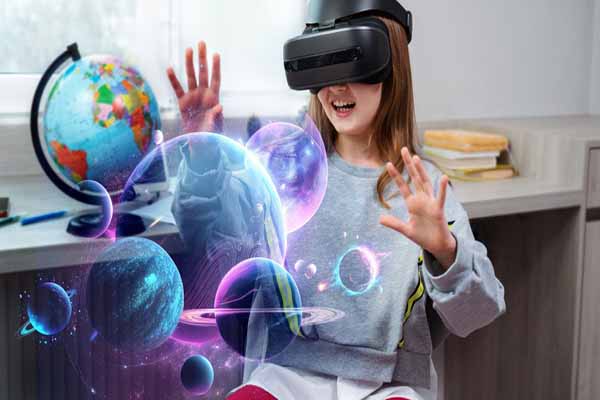The 21st century is witnessing a technological revolution, with Augmented Reality (AR) and virtual reality (VR) transforming education. AR is making learning more immersive, engaging, and personalized, offering a glimpse into the future of learning.
The widespread adoption of these technologies is driven by technological advancements that are revolutionizing education by allowing students to explore the outer world and dissect virtual organisms from the confines of a classroom. These hands-on, experiential learning methods are redefining traditional teaching methods, making education more engaging and sustainable to resolve real-world problems such as environmental pollution.
Rise of Transformative Education through AR Adventures
Traditional lectures struggle in the digital age, but AR injects excitement by making lessons interactive. In the pursuit of creating an enriching educational experience, educators and technologists are increasingly turning to Augmented Reality, allowing students to explore 3D models, dissect virtual organisms, and delve into complex structures. This dynamic method enhances comprehension and retention, turning learning into a visually stimulating adventure.
AR’s accessibility through smartphones and tablets enables students to access content from anywhere, breaking geographical barriers. This flexibility ensures an inclusive learning experience beyond the confines of the classroom. It also fosters collaboration through shared experiences, enhancing teamwork and communication skills. Collaborative projects and simulations mirror real-world scenarios, preparing students for success in their future careers. Furthermore, STEM education, encompassing Science, Technology, Engineering, and Mathematics, is also experiencing a transformative boost through the integration of Augmented Reality (AR).
Advantages of AR and VR Technology in Education
Improved Engagement
Through applications like AR interactive lessons and VR virtual field trips, students are captivated, fostering a dynamic and participatory learning environment that goes beyond traditional methods, making education more compelling, for instance, AR overlays 3D models on textbooks, making lessons dynamic.
AR and VR technologies immerse learners in virtual environments, offering realistic and interactive experiences. From VR simulations for hands-on practice to AR overlays in textbooks, students engage with subjects in three-dimensional spaces. This immersive approach transforms education, providing a deeper understanding and fostering a more dynamic and memorable learning experience.
Personalized and Adaptive Learning
AR and VR technologies enable personalized and adaptive learning by tailoring content to individual student needs. AR adapts lessons based on progress, while VR creates customized simulations. This approach ensures that each student receives a tailored educational experience, optimizing comprehension and engagement in the learning process.
Global Connectivity
Virtual classrooms that transcend geographical boundaries enable students to collaborate, share experiences, and learn together. For example, platforms like ENGAGE VR facilitate virtual classrooms where students from different countries attend lectures, interact, and collaborate on projects, breaking down traditional barriers and offering a truly interconnected and globalized educational experience.
Practical Skill Development
AR and VR technology in education bridge the gap between theory and practice, providing valuable experiential learning opportunities that prepare students for real-world challenges in their respective fields. For instance, in medical education, VR enables students to perform virtual surgeries, refining their surgical techniques and decision-making skills. This hands-on experience in a risk-free environment accelerates the development of practical expertise. Similarly, in engineering education, VR simulations allow students to experiment with designs and prototypes, enhancing their problem-solving abilities.
In a nutshell
As we navigate the future of education, the rise of transformative learning through AR adventures is a beacon of hope. This innovative technology has the potential to reshape the educational landscape, making learning more engaging, accessible, and future-oriented. AR is also fostering collaborative learning environments, connecting students across the globe and enhancing their understanding of current world challenges.















